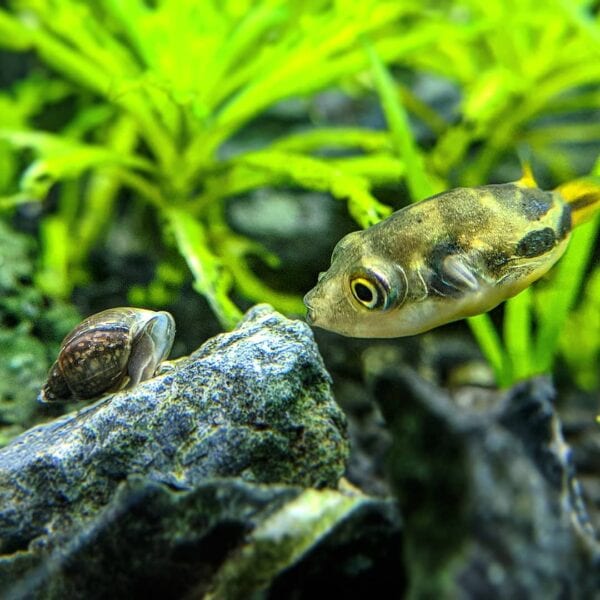
Bladder snails usually popup in an aquarium, and in a few weeks, they can multiply and make their presence felt, mainly by their remarkable breeding speed and you’ll start to see everywhere speeding around (for a snail!).
These creatures have a unique trait that sets them apart from other snails: their shells spiral to the left! Interesting, right?
Bladder snails were equipped with the interesting ability to shake off leeches and other problematic crawling organisms that may be hitching a free ride on their backs. So in aquariums, you might see these snails sometimes violently shaking their shells to unload a hitchhiker!
Some have also been reported to be able to take in air and actually float around the tank like a hot air balloon! (this is a less common behavior in aquariums with more water flow; snails in tanks with sponge filters often exhibit this unexpected behavior).
For the aquarists who are willing to take a closer look at the notorious, oddball bladder snail, one might just find it to be one of the most interesting additions to any well-maintained tank
Table of Contents
Bladder Snail: A Quick Summary
Bladder snails, also known as Physidae, are a type of small freshwater snail that is native to Europe and North America. They are a common pest in aquariums and are known for their ability to reproduce quickly. Bladder snails are omnivorous and will feed on a variety of plant matter and detritus.
Summary
| CATEGORY | RATING |
| Class | Gastropoda |
| Family | Physidae |
| SubTypes | Moss bladder snail (Aplexa hypnorum) Acute bladder snail (Physella acuta) |
| Relatives | Physella heterostropha Physella gyrina |
| Size | About ½ inch overall |
| Lifespan | 3-5 years |
| Preferred water | Freshwater, pH 7-8 hard water Tolerates acidic deoxygenated water |
| Temperature | 64-84 degrees Fahrenheit |
| Diet | Algae and decaying plants |
| Temperament | Peaceful |
Bladder Snail Overview
Bladder snails don’t have a distinct origin, some theories claim that they were first found in Eastern Europe while others demonstrate that they started in Central America and spread from there to the rest of the world.
Bladder snails are found in warm freshwater where they prefer standing ponds, but they fair nicely in slow-moving streams too. However, they can also survive at the banks of larger lakes.
We think you may be interested in: Best Fish For Ponds
Usually, a few bladder snails wouldn’t cause a problem because they can be helpful to clean up the rotting remains from the aquarium. Some breeders also keep them in a separate aquarium to use as food for other fish.
Bladder Snail Appearance
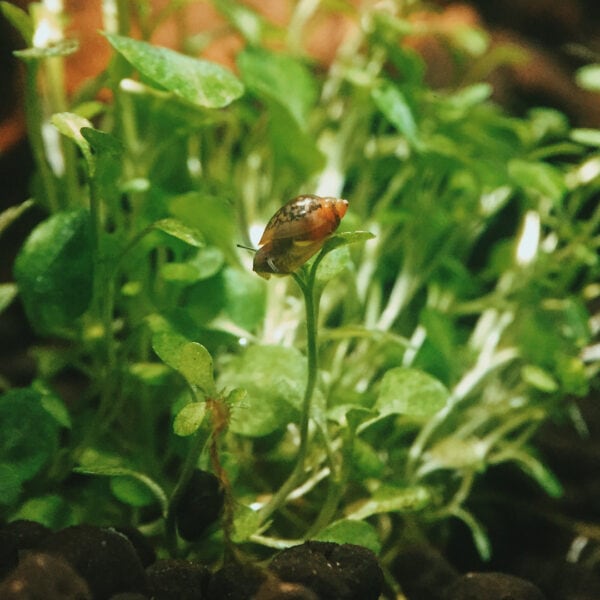
The bladder snail has a hard translucent shell with very distinct golden markings on a yellow background. The shell is mostly round with a right mantle lobe and an apex at its rear end. The color of the snail is dark with a mixture of black, grey, and purple lace-like patterns.
Bladder snails have an operculum, a trapdoor-like structure that seals the shell’s opening. That enables them to protect themselves from predators. Speaking more about their appearance, they have eyes near their tentacles, and they can move slowly utilizing their muscular feet.
The shells are generally spiral-shaped and elongated along with a long aperture. The shell will be white in most species, but you can also see other colors, like yellow and brown. The length of the shell can move up to 8 millimeters.
The body size of the bladder snails is quite small, retractable, and has a brownish-gray mass. On their head, you will find two pairs of tentacles. The most interesting fact about these snails is that they use one pair for seeing and another for smelling. They have feet to move around, and your snails can move easily up the aquarium.
Bladder Snail Behavior
Different from other freshwater snails, bladder snails normally don’t retreat into the shells even after sensing danger around them. Now, you might be wondering why? The major reason behind this is they don’t have any lid. They normally begin shaking their body violently to avoid any possible danger.
Besides, if required, they can also swim down to the bottom of the tank and can keep breathing. They expel the air and quickly submerge in water whenever they sense any danger. However, they are not capable of digging into the ground. But to protect themselves, they can crawl much faster through the water.
Bladder Snails Average Lifespan
Experts say that a healthy and good bladder snail can live around 2 years. But you should keep in mind that your snails’ life expectancy can greatly depend on a suitable living condition. It has been seen that Bladder Snails generally succumb to different illnesses quite earlier than other species.
They can thrive properly in a dirty aquarium. A dirtier aquarium can provide them with more feeding opportunities. In such an environment, they will live longer and breed better.
Bladder Snails Average Size
As discussed above, bladder snails are hermaphroditic gastropods, and their reproduction method is by laying eggs. The average size of the snails is 1/2 inch.
However, some bladder snails can grow around 0.6 inches. Speaking about their shells, they are an oval shape, and the length of the shell can go up to 2 to 4 mm, and the width can range up to 1.5 to 2 mm. Even though they are small, they can also stress your aquarium resources. They can have a major impact on the bio-load. If you don’t consider this seriously, your snails can have a huge toll on the fish living in the tank.
The Difference Between Pond And Bladder Snail
It has been seen that most people mistake the bladder snail for normal pond snails. It is very easy to get confused with this as they have an amazing skill cohabitating in any environment perfectly. As per some studies, bladder snails can be easily found in every region across the world, except Antarctica. In fact, they have spread so much that it is quite difficult to identify their origin. Even though they both will appear similar, you can spot some differences if you do a close inspection. These are:
- The size: If you compare the size of a pond snail and a bladder snail, you will find that pond snails are 2 to 6 times bigger than bladder snails.
- Different shell: In the case of pond snails, their cover will be brown and opaque. On the other hand, bladder snails come with yellowish and translucent covers. Besides, if you observe closely, you will find that the shape is also different.
- The tentacles: All the pond snails come with thicker and triangular tentacles. However, the bladder snails have thin and thread-like tentacles.
There is another important thing that you should keep in mind. The bladder snail species are completely sinistral. That means their shell generally spirals to the left, which is very rare among the mollusk species. Pond snails are generally dextral and come with shells twisted to the right. Besides, no bladder snails have the operculum lid, which is quite common among other snails, and they use that to keep themselves protected.
Propagation
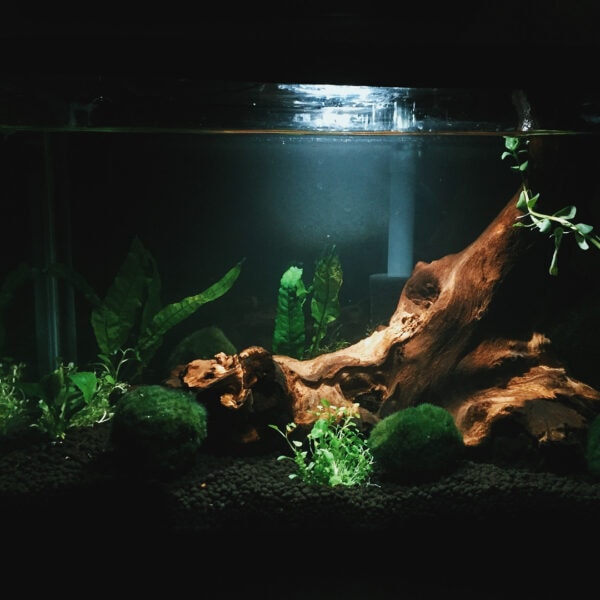
Bladder snails are rarely brought into an aquarium intentionally, they usually get into an aquarium by latching on to plants or their eggs are caught in the same net with other coveted pet fish.
Once they arrive in an aquarium, they hide for a few days under the gravel and then foray outside to feed and explore.
Bladder snails move at a remarkable speed and they have a conspicuous form, so they’re hard to miss.
They also multiply actively and enthusiastically, often completely on their own while not necessarily needing a mate from the opposite sex.
Do Bladder Snails Eat Plants?
One of the most common questions by aquarists, especially ones with meticulously-trimmed and aquascaped tanks, is whether or not a bladder snail will ruin aquatic plants indiscriminately. Unfortunately, however, there is no straight yes or no answer here; it’ll depend on the type of environment your aquarium has.
Bladder snails developed a preferred menu consisting mainly of decaying plant matter and algae in their natural habitat of standing water and swamps.
Sometimes in the wild a snail pond dries up caused by seasonal or human intervention, and in that situation, the bladder snail runs off to the nearest decaying plant clump and feeds there.
Bladder snails living in an aquarium follow the same general pattern of nibbling on decaying matter, but in that case, it’s mostly excess fish food.
If you keep a tightly-controlled tank with little-to-no scraps of food and algae for the bladder snail to munch on, then chances are, your snail will take a nibble from the decaying and/or softer leaves of your plants from time to time.
However, they rarely approach the aquarium plants and that’s why several fish breeders consider bladder snails as benign scavengers that just keep the biome clean. Provided they stay in controlled amounts of course.
Controlling a Bladder Snail Infestation
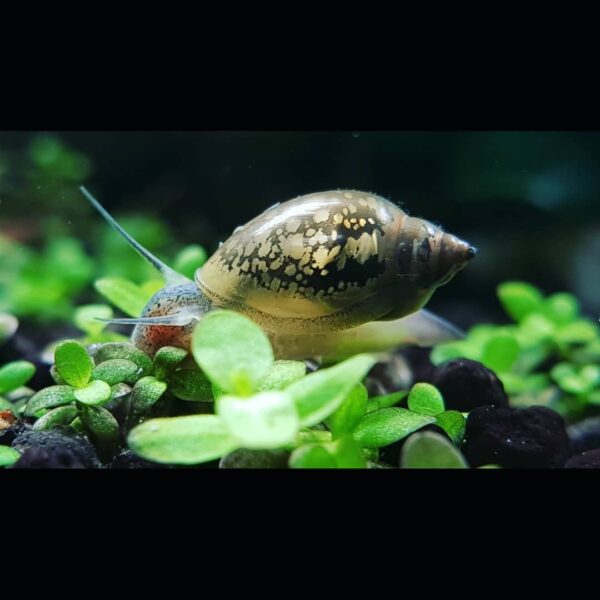
If you find yourself having hoards of snails run over your plants, you may be doing one of the following:
- Feeding too much – fish love to beg for food, and aquarists often fall into the trap of overfeeding the fish. The problem with overfeeding is that not only will can fish end up getting obese, but they’ll also produce more fish waste, which is then consumed by both algae and plants.
In tanks that have high levels of phosphate and nitrate this can be a problem as algae thrives in nutrient-dense tanks. The surplus of algae and uneaten food makes one’s tank a haven for large groups of bladder snails. Feed sparingly, and use high quality food to keep your tank’s water quality high and your bladder snail population low. - Inconsistent Water Changes – related to overfeeding, inconsistent water changes allow waste to build up, therefore providing algae a suitable environment to grow in and thrive.
Algae can easily outcompete plants for the necessary nutrients, and even block their leaves, therefore making them much weaker. Eventually, the snails and fish take a nibble or two from the wilting leaves from time to time, without the plant being able to heal and grow at a faster pace.
This is dangerous, as tanks like these are often headed for a crash, and the burst of snail growth is a sign that one must take action soon before it’s too late.
Fortunately, if you’ve fixed problems 1 and 2, you should be easy to get rid of the excess snails you might still have in your tank. Here are some of the more popular ways of removing excess bladder snails:
- Setting up lettuce traps – the favorite vegetable of the bladder snail is romaine lettuce. This makes it easy for you to trap them; simply drop a romaine lettuce leaf at the bottom of the tank and collect the snails you don’t need.
You can either drop them off at a pet shop or give it to someone who needs them (usually people who keep loaches or puffer fish). - Buying bladder snail predators – you can also control a bladder snail infestation by introducing predatory creatures that see the bladder snail as a snack into your aquarium.
Read on below to see what time of fish can help you solve this problem.
What Fish Eat Bladder Snails?
Bladder snails are the natural prey for some omnivorous or carnivorous fish. These predators mostly see a snail as a long-awaited yummy treat.
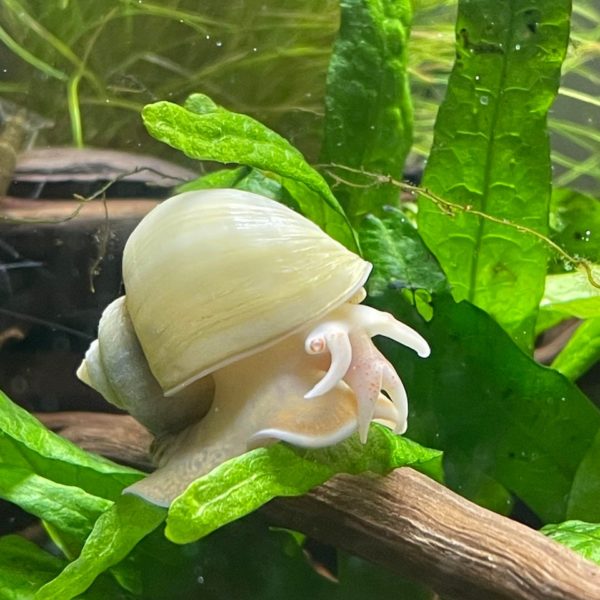
This behavior is consistent in the fish’s natural habitat. In an aquarium, however, fish could exhibit different behavior where it might ignore the snail and show interest in other types of food.
These are some of the fish that normally eat bladder snails:
Green Spotted Pufferfish
Green Spotted Pufferfish is originally from the fresh waters of southeast Asia where it’s well versed in waterbed hunting and has a special craving for hard-shelled snails. Munching snails is good for their jaw.
Green spotted puffers are pretty looking fish with a flaring temper. They aren’t very sociable and love to eat up their little neighbors.
They could tolerate having a mate around the aquarium but that’s not always going to be the case because a lot of the time they may just as well eat them up too.
Betta Fish
Betta fish is another cruel beauty. It has an aggressive attitude that contrasts with its angelic shape and demeanor.
Betta fish like Green spotted puffer are an Asian freshwater fish that used to dwell in swamped rice fields.
Betta is a carnivore that’s often nicknamed siamese fighter, so it’ll eat bladder snails and pretty much any good protein.
Size matters though, and as it’s a small fish it’ll only approach the eggs and baby snails.
Yoyo Loach Fish
Loach fish are freshwater sociable fish with a lovely demeanor and a huge appetite for bladder snails.
Yoyo Loach, got that funny name from the markings on their backs which spell a clear ‘yo-yo’. They’re generally nice towards the other fish in the aquarium but these snails are not very safe around them.
They occasionally act a little naughty, especially if there are five or six of them, and these playful episodes tend to disturb the other fish a little.
They’re also pretty large for aquarium fish as they can grow to 6 1/2 inches, which then requires a spacious aquarium for comfort and well being.
Crayfish and Assassin Snails
These aren’t actually fish, crayfish is a crustacean and assassin snails are mollusks – but they’re common in an aquarium and they both have encounters with bladder snails.
Crayfish likes the taste of snails, but they can be a bit picky when it comes to shell hardness and size – this crustacean prefers smaller and softer snails.
Assassin snails don’t mind size much, and it’ll probably clean up a whole aquarium from a snail infestation. They like to hunt snails, but it’ll take its time though – you can’t rush talent.
Crayfish and assassin snails are considered natural prey for other aquarium fish, so they might be eaten by a potential predator before they could handle the bladder snail issues.
Are Bladder Snails Asexual?
It’s common for invertebrates like worms and snails to be asexual, or hermaphrodite. They have both male and female reproductive syestems, but they normally choose to behave as one or the other.
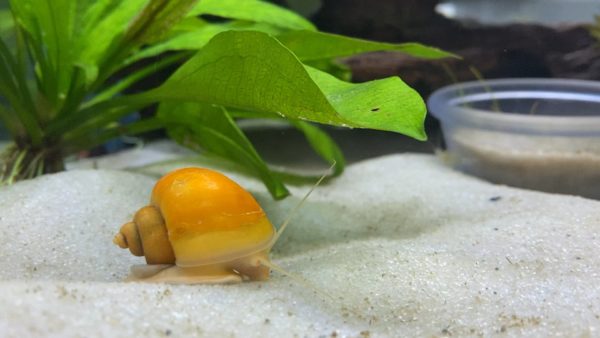
The dating and courting patterns for bladder snails are quite typical of guy meets girl, until they find themselves completely single, then they try something else.
A snail that finds itself alone in a pond or aquarium will start breeding on its own, it doesn’t have the patience to wait forever.
Usually, a couple of snails breed as soon as they land in an aquarium while a snail that believes there are no mates available would consider single parenthood after about 8 weeks.
Inbreeding isn’t the best option for snails, and hermaphrodite vertebrates in general, it’s the last resort because the offspring are often weaker and less viable than the parent.
The 8-week mark is cut off and shortened significantly if the snail feels threatened. That’s when survival kicks in and the bladder snail starts a family right away.
Bladder Snails Care & Tank Set-Up
One of the best things about bladder snails is they can survive in the most challenging conditions. They generally prefer to live in slow-moving warm water, and you don’t have to worry about dirty water if you have only bladder snails in the tank. Always remember that they normally feed decaying plants and algae. That means dirt water can serve as their source of food.
Bladder Snails Tank Size and Specifications
Tank Condition
They can live in hard and soft water, and they can also survive in different ranges of pH. They live well in different temperatures and can reproduce under the water temperature of 60 to 85-degree F. But per, some studies demonstrate a better reproductive rate in a cool climate.
Some researchers have found that under a temperature of 58-degree F, they attain their sexual maturity at 35 to 40 days. When the water temperature was at 82-degree F, they tool around 18 days to attain sexual maturity.
Aquarium Size
They don’t have any maximum or minimum tank size requirements. In fact, they can reproduce and expand almost everywhere. However, the tank size requirements should be based on the type of dish that you want to keep in the tank. But it can be said that a smaller tank with more fish can produce more waste and a perfect environment where bladder snails can reproduce faster.
Water Parameters
There is no such hard and fast rule for these snails. They are adaptable and can thrive under various conditions. But warm water is good for them. However, they are undemanding. Just stick to the below-mentioned parameters to make sure they can live properly.
- Water hardness- Around 12 to 18 dGH.
- Water temperature- Around 64-degree F to 84-degree F.
- pH levels- around 7 to 8.
Calcium
Remember that you need to add calcium into the tank as bladder snails need sufficient calcium for shell development. When there is a lower calcium level, their reproductive levels and growth rate can go down.
If you want to use bladder snails to keep your aquarium clean, then adding cuttlefish bones and eggshells into the tank can be a good idea.
Baby bladder snails have softshells, and they will immediately start searching for sources of calcium to develop and strengthen their shells.
Filtration
They are tolerant of any poor water quality, and they don’t need an efficient and strong filtration system as they generally feed on algae or detritus. However, using a good filtration system is recommended to lower the stress on the inhabitants.
Bladder Snails Breeding
It is a fact that bladder snails are naturally hermaphroditic, and they have the ability of cross-fertilization or self- fertilization. They generally lay their eggs in the gelatinous mass, attached to plants or other aquarium objects.
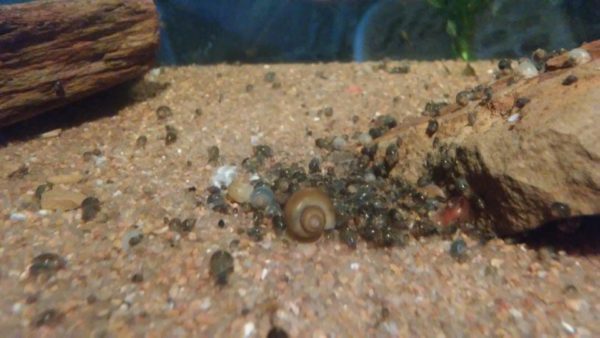
Their eggs hatch in around 14 to 20 days. A young snail can reach maturity within just three months. Well, it can be said that breeding your bladder snail is very easy. The only effort you need to put in is providing them with sufficient food and the right tank condition. Here are some important steps you may need to follow to successfully breed your bladder snails.
Offer Them The Right Tank Conditions
They perform well in the densely planted tank, along with sufficient open areas where they can crawl. Such a tank setup can offer them the right conditions to begin the breeding procedure. So, keep them in such condition.
Right Food
As they are omnivores, they can eat any type of food. If you want to make them breed properly, you will have to provide them with plenty of decaying plant matter and algae in their diet.
Wait For Them To Start Breeding
They have a sperm storage organ, and the existence of females and male reproductive organs enables them to reproduce through cross-fertilization and self-fertilization. They will self-fertilize when they are unable to find a partner. However, you should allow them for this as they can die during the process. One snail will climb on the other snail’s shell and then slowly crawl over the reproductive organs of the partner. This may take around 30 minutes.
They lay egg capsules, and each capsule may contain around 10 to 50 eggs. Under the right environment, the eggs can take six to seven days to hatch. Up to 90 percent of eggs hatch into baby snails, measuring around 1mm.
Are Bladder Snails Perfect For Your Fish Tank?
Well, it is all up to you to decide whether you want to bring a bladder snail to keep your tank clean or not. While thinking that, you should also consider the effort and time you will have to put in to prevent them from overrunning your aquarium.
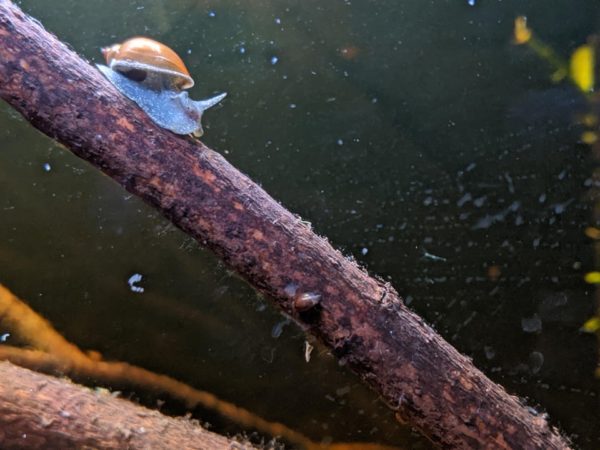
Bladder snails are natural scavengers and can keep your aquarium in good condition for a long time, providing you do your task to keep the aquarium clean and feeding your fish properly. Well, as they breed very fast, you will have to ensure that the population of your bladder snail in the aquarium is under control.
If you want to get rid of excessive bladder snails, you can add a predator fish to the tank. But be careful about that as they may also eat other fish.
Bladder Snails Diseases And Treatments
As they are scavengers, they fall ill very rarely. But as they can eat anything, sometimes it can be very difficult for them to digest the foods properly. However, some common health issues that your bladder snail can develop are indigestion, poor nutrition, bacterial or fungal infections, and shell damage. Even parasites can infect them, but such cases are very rare. They can shake microorganisms and worms off their body.
There are no such treatment options available for bladder snails. However, by keeping the tank clean and providing them with a healthy diet, you can keep them crawling slowly around the tank for years.
FAQs
Do They Eat Plants?
You will not find an accurate answer to this particular question because this greatly depends on the surrounding environment. For example, if your tank is properly controlled with no algae or food scraps, then the bladder snails will start decaying as well as soft plan leaves. But this is a rare incident. As per the experts, they are benign scavengers. Just keep the biome clean, and you are all set to keep them with the plants.
Are They Asexual?
Just like most invertebrates, bladder snails are also asexual. Bladder snails have female as well as male reproductive organs. On the other hand, the mating pattern of these snails is also normal unless they are alone. Remember that if they are alone, they can begin breeding independently.
What Is The Best Way To Control Snail Infestation?
Well, there are three different ways to control your bladder snail infestation. The first one is by adding a predator to your aquarium. What’s more? You should not feed your fish more because excess feed can lead to more fish waste, making the aquarium heaven for them. Besides, you should change the tank water inconsistently as this can lead to waste build-up, creating a thriving environment for them.
Do These Snails Need A Heater?
No, they don’t need a tank heater. They remain healthy and can thrive well under your regular room temperature. So, if there are no such huge temperature fluctuations, there is no need to use a heater for them.
Do These Snails Consume Fish Poop?
Some people think snails while roaming around the tank, eat fish poop. But this is not true. In fact, your bladder snails are just like cleaning fish. They never eat fish poop, and they consume decaying plants and algae.
Conclusion
Bladder snails are quite peaceful creatures and they can enhance the wellbeing of the aquarium environment by constantly eating the scraps and keeping them from rotting and spoiling the water. However, do tend to procreate extravagantly and may need some active measures to keep their numbers in check.
Adding a natural predator that craves bladder snails is sometimes a good setup, but choosing the right fish could be challenging as they might show aggressive behavior towards the other fish. In addition to this caution, if you want to preserve some of the bladder fish population you will need to be careful how many predators you add as they may decimate the whole population.
Take these two points into consideration when do decide whether or not to add bladder snails into your aquarium.
No related posts.

2 thoughts on “Bladder Snail: Complete Guide to Care, Breeding, Tank Size and Disease”
When I saw the first egg sack, I thought, “awww baby snails, how exciting!” …Now my tank is being swarmed. I’m not overly keen on killing the wee guys, but my betta does not seem to be interested in eating them and they are getting bigger!
Does anyone have any idea how many bladder snails would be appropriate for a 10 gallon tank? How many snails is too many?
Ok so I took one of my bladder snails and put it into another aquarium for about the first 5- 10 minutes it did fine then a betta fish knocked it of a stem of horn wort and the all of a sudden it started to float around the tank….all the water parameters are the same in both tanks…why did it do that?